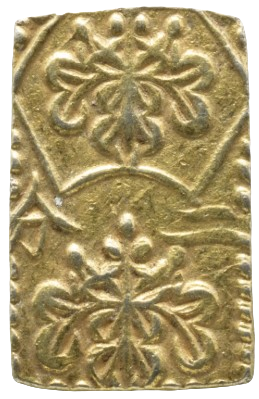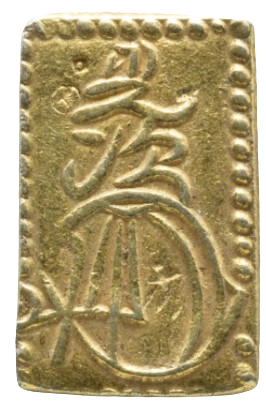Man’en Nibu Ban Kin
(万延二分判金)


(Ginza Coins Collection, Tokyo. Reproduction authorized. © All rights reserved.)
Introduced in 1860, the Man’en Nibu Ban Kin was one of the last fractional gold coins issued by the Tokugawa shogunate. Lighter than its predecessor, the Ansei Nibu, but made with a slightly improved alloy, it was intended to restore confidence in the monetary system and support public finances. Its wide circulation, greater than that of other coins such as the Man’en Koban, contributed to the shift in commercial transactions from the ryō unit to the nibu, reflecting Gresham’s Law, which states that "bad money drives out good." In 1865, the Man’en Nibu became central to a major financial operation led by the reformist Oguri Tadamasa. Through its recoinage, the shogunate raised funds for the construction of the Yokosuka Naval Arsenal, a key project for Japan’s military modernization, without increasing taxes. For this reason, some historical documents referred to it as the "Oguri Nibu Kin." The coin was officially withdrawn in 1874 during the monetary reforms of the Meiji era.
| Coin Name | Man’en Nibu Ban Kin |
| Japanese Inscription | 万延二分判金 |
| Historical Period | Edo Period (1603-1868 d.C.) |
| Year of Minting | 1860 – 1868 d.C. |
| Chronological Reference | Japan |
| Minting Location | Edo |
| Issuing Authority | Clan Tokugawa (Tokugawa Iemochi) |
| Function | Officially minted Value 2 Bu |
| Material | Gold (22.9 %) Silver (77.1%) |
| Shape | Rectangular |
| Height | 2.0 cm |
| Width | 1.2 cm |
| Weight | 3.0 g |
| Manufacturing Technique | Mold casting |
| Obverse Text and Symbols | Gosan Kiri seal inscribed in a fan-shaped design. Free-standing Gosan Kiri seal. Character bu 分 in the Hane Bu (ハネ分) style. Character ni 二 (two) |
| Reverse Text and Symbols | Inscription Mitsutsugu (光次) and kaō |
| Calligrapher / Artist: | Gotō Yoshigoro Mitsuhiro |
| Museum References | |
| Number of Known Specimens | 93.000.000 pezzi prodotti |
Sources and Bibliography
The Gold of Tokugawa, Alberto Rolfini 2025
瀧澤武雄, 貨幣 Takizawa Takeo, Kahei Nipponshi sho Hyakka 1999
